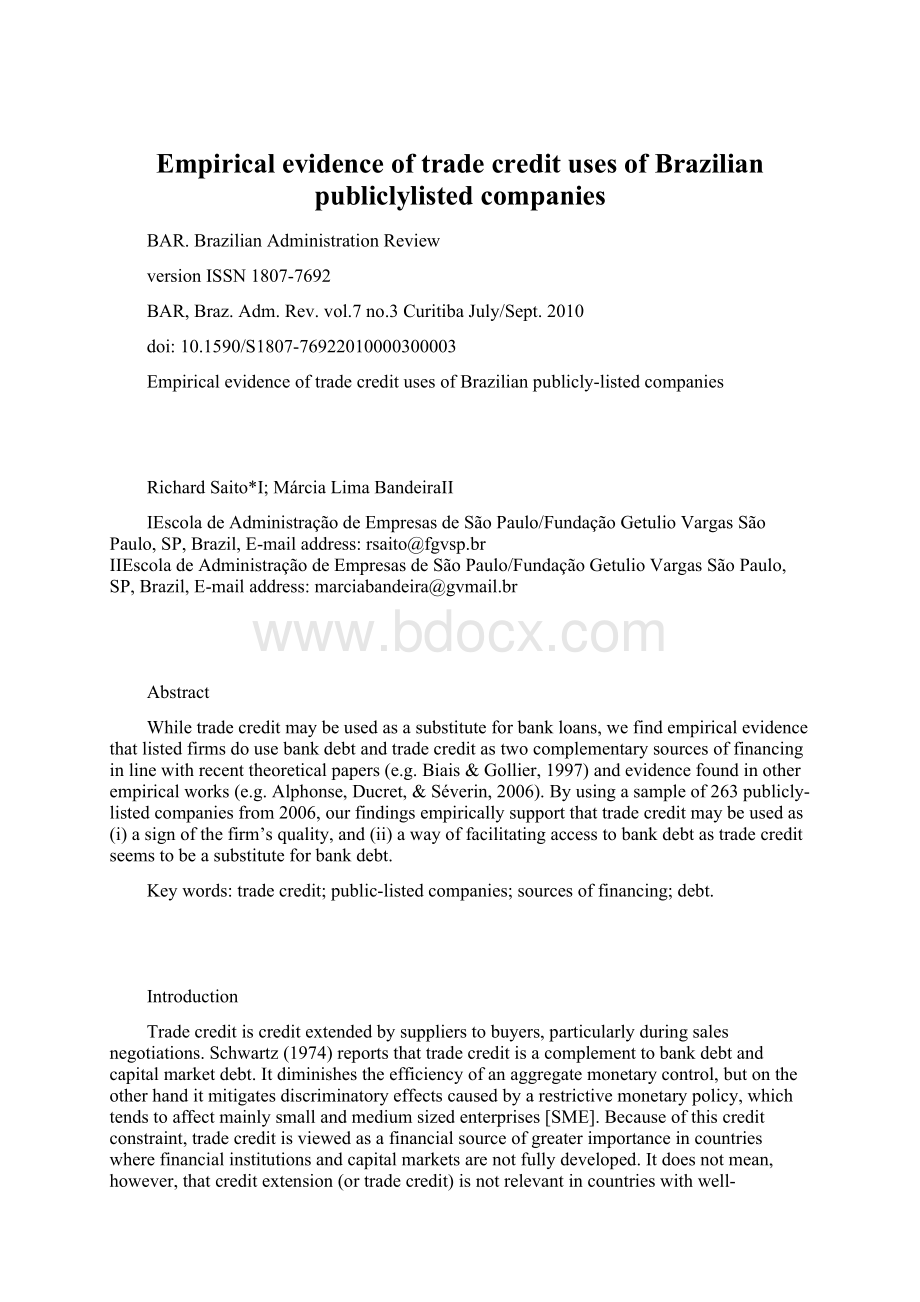Empirical evidence of trade credit uses of Brazilian publiclylisted companies.docx
《Empirical evidence of trade credit uses of Brazilian publiclylisted companies.docx》由会员分享,可在线阅读,更多相关《Empirical evidence of trade credit uses of Brazilian publiclylisted companies.docx(13页珍藏版)》请在冰豆网上搜索。

EmpiricalevidenceoftradecreditusesofBrazilianpubliclylistedcompanies
BAR.BrazilianAdministrationReview
version ISSN1807-7692
BAR,Braz.Adm.Rev. vol.7 no.3 Curitiba July/Sept. 2010
doi:
10.1590/S1807-76922010000300003
EmpiricalevidenceoftradecreditusesofBrazilianpublicly-listedcompanies
RichardSaito*I;MárciaLimaBandeiraII
IEscoladeAdministraçãodeEmpresasdeSãoPaulo/FundaçãoGetulioVargasSãoPaulo,SP,Brazil,E-mailaddress:
rsaito@fgvsp.br
IIEscoladeAdministraçãodeEmpresasdeSãoPaulo/FundaçãoGetulioVargasSãoPaulo,SP,Brazil,E-mailaddress:
marciabandeira@gvmail.br
Abstract
Whiletradecreditmaybeusedasasubstituteforbankloans,wefindempiricalevidencethatlistedfirmsdousebankdebtandtradecreditastwocomplementarysourcesoffinancinginlinewithrecenttheoreticalpapers(e.g.Biais&Gollier,1997)andevidencefoundinotherempiricalworks(e.g.Alphonse,Ducret,&Séverin,2006).Byusingasampleof263publicly-listedcompaniesfrom2006,ourfindingsempiricallysupportthattradecreditmaybeusedas(i)asignofthefirm’squality,and(ii)awayoffacilitatingaccesstobankdebtastradecreditseemstobeasubstituteforbankdebt.
Keywords:
tradecredit;public-listedcompanies;sourcesoffinancing;debt.
Introduction
Tradecreditiscreditextendedbysupplierstobuyers,particularlyduringsalesnegotiations.Schwartz(1974)reportsthattradecreditisacomplementtobankdebtandcapitalmarketdebt.Itdiminishestheefficiencyofanaggregatemonetarycontrol,butontheotherhanditmitigatesdiscriminatoryeffectscausedbyarestrictivemonetarypolicy,whichtendstoaffectmainlysmallandmediumsizedenterprises[SME].Becauseofthiscreditconstraint,tradecreditisviewedasafinancialsourceofgreaterimportanceincountrieswherefinancialinstitutionsandcapitalmarketsarenotfullydeveloped.Itdoesnotmean,however,thatcreditextension(ortradecredit)isnotrelevantincountrieswithwell-developedfinancialinstitutionssuchastheUSorGermany.TradecreditisalsoviewedasanimportantsourceoffinancingforSME,sincethesefirmsnormallyhavelessaccesstosourcesoffinancing(andarealsomoreaffectedbyrestrictivemonetarypolicies).However,tradecreditismuchusedbylargefirms.Inoursample,forexample,tradecredituserepresentsaround8%oftotaldebt,or1/3offirms’financing(excludingcorporatedebt).
DespitetherelevanceoftradecredittoBrazilianfirms,thereisnoliteratureaboutthissourceoffinancingusingBraziliandata.Thisstudyaimstofillthisgap.AnotherinnovationintroducedbythepresentstudyisthefocusonBrazilian-listedfirms.Itisreasonabletoexpect,therefore,thattheyhaveatleastthesameaccesstobankloansasprivatefirms.Inaddition,publiclistedfirmshaveaccesstopublicdebtwhileprivatefirmsdonot.Nevertheless,thecomplexproceduresforaccessingtheseothersourcesoffinancing,theproportionallylargerfinancingneedsofpublicfirmsandtheirneedtodiversifytheirfinancingsuggestthattradecreditmaybejustas(oralmostas)usefulforpublic,largefirmsasitisforsmallerones.
ThisstudyinvestigatestradecreditfromtheviewpointofbothsupplierandbuyerbasedonasampleofBrazilianpublicfirms’data.WetestthehypothesisofAlphonse,DucretandSéverin(2006)whoarguethatcreditrationedfirmswouldusetradecreditascomplementaryandalternativesourceoffinancing,whilefirmsnotfacingcreditrationingwoulduseitonlyasanalternativesource.Theanalysisoftradecreditsupply(thesupplierviewpoint)focusesonfirms’accesstocredit.
Theremainderofthispaperisorganizedasfollows.TheliteraturereviewandhypothesesarepresentedinSecondSection,datadescriptioninThirdSectionandtheempiricalresultsandthediscussionofresultsinFourthSection4.FifthSectionconcludes.
LiteratureReview
Firmsjustifysupplyingtradecreditonthebasisthat,intheabsenceofsuchfinancing,clientswhodonothaveaccesstocreditfromfinancialinstitutionswillnotbuytheirproducts(Nadiri,1969).Emery(1984)arguesthattradecreditprovisionboostssales,representingastrategytoreducefirms’inventorieswithoutpricecuts.Inthissense,thisstrategywouldavoidcostsassociatedwithpricereductionandpreservethefirms’discretionarypricingability,aspointedoutbyPetersenandRajan(1997).Aninstrumentthatfacilitatesthispracticeisthetradebill,whichcanbediscountedinadvance.
Anotherrelevantaspectoftradecreditisthatitplaysaroleasaproductguaranteewhenasupplier’sreputationisnotwellknown,sinceclientscanobservethequalityofproductsbeforeeffectivelypayingforthem(Smith,1987;Long,Malitz,&Ravid,1993).
Wilner(2000)additionallyarguesthat,forasupplierthatreliesonaspecificcustomer,itmaybeinthesupplier’slongtermintereststogranttradecredittothiscustomerevenifthesupplierissufferingtemporaryfinancialdistress.Inthissense,theauthorverifiedthatlargebuyersfacedwithcreditrestraintsmayusetheirposition(asalargecostumer)toobtaintradecreditfromtheirsuppliers.
Althoughthesereasonsjustifytheinterestofnon-financialfirmsinextendingtradecredit,itisstillinterestingtoaskwhytheydosointhepresenceoffinancialfirmsspecializinginsellingcredit.Theanswerisdirectlyrelatedtoriskmitigationbynon-financialfirmsinrelationtobanks.AccordingtoPetersenandRajan(1997),theexplanationismostlyrelatedtoinformationaladvantagesthatsuppliersexperience,comparedtobanks,duetotheirbusinessrelationshipwiththeirclients(Thesuppliers’visitstotheirclientsmayprovideusefulhintsaboutinventories,employeeredundancy,clients’complaintsandotherproblemsthatthebuyermayeventuallyface).
First,suppliersmayobtaininformationabouttheircustomersinthenaturalcourseofbusiness,henceinamoretimelyandlesscostlywaythanbanks.AsCook(1997)pointsout,thiscanbeexplainedbythefactthatsuppliersvisittheircustomersonaregularbasis:
insuchvisits,suppliers’representatives(salespeople,commercialmanagers)getintouchwithbuyers’employeesandrepresentativesofotherfirms,obtaininginformationabouttheirrelationshipwiththebuyer.Anotherfacilitatingfactoristhatsuppliersandbuyersfrequentlybelongtorelatedindustries,whichmakesiteasyforthesupplierstohaveagoodassessmentoftheircustomers’marketconditions.Moreover,PetersenandRajan(1997)pointoutthatthefrequencyandvolumeofpurchasesprovidearelevantsignalaboutthecustomer’ssituation.
Thebusinessrelationshipalsoprovidesthesupplierswithamonitoringadvantage.MianandSimth(1992)statethat,facedwithalikelydefault,thesuppliercancutfuturessales.Thisattitudecanbeharmfulandeventriggerthefirm’sshutdown,especiallyiftherearefewalternativesuppliersofthatinput.Ontheotherhand,retaliationfromfinancialinstitutionsdoesnothaveasimmediateaneffectasthesuppliers’actions.Knowingthatsuppliers’retaliationcanleadtotheirshutdown,buyershaveanextraincentivetoavoiddefaultingontradecredit.Furthermore,BuckartandEllingsen(2004)arguethatgoodsaremoredifficulttodivertthancash,thatis,supplierscanovercomemoralhazardeasierthanbanks.
ThelastadvantagementionedbyPetersenandRajan(1997)hastodowiththenatureofcollateralassets.Incaseofdefault,lenderscanseizethebuyers’inventoryofgoods:
however,giventhenatureoftheiractivities,suchassetsarelessvaluabletobanksthantosuppliers(seealsoFrank&Maksimovic,2004andLonghofer&Santos,2003).Alltheadvantagesofnon-financialfirmsarerelatedtoriskmitigation,sincethesefirmscanreduceinformationalasymmetry.
Finally,itisimportanttoexplainwhyfirmsusetradecreditevenifitisconsideredmorecostlythanotherformsofcredit.Therearetwomainreasonsfortheinterestinitsuse:
(1)tradecreditisanalternativesourceoffinancing,especiallywhenfirmsarecreditconstrainedand
(2)itisviewedasasignofgoodqualityoffirms,makingiteasierforthemtoaccessbankloans.
BurkartandEllingsen’s(2004)modelpredictsthat,inthecaseofwealthyfirms,theuseoftradecredithasanegativerelationshiptowealth.Moreover,accordingtotheseauthors,theleastwealthyfirmsusebankloansandtradecredituptotheirlimit.Cunninghan(2004)empiricallyverifiesBurkartandEllingsen’smodel(2004).Bydefiningwealthasnetincomebeforetax,shefoundthat,formedium-wealthfirms,asthelimitofbankcreditincreases,tradecreditislessused;andforlow-wealthfirms,theyaredirectlyproportional,whichsuggeststhatthistypeoffirmexhaustsbothlimitsofbankcreditandtradecredit.
PetersenandRajan(1997)foundthatcreditconstrainedfirmsusemoretradecredit,whilefirmswithmoreaccesstocreditfromfinancialinstitutionsextendmorecredittotheircustomers;theseresultswerefurthercorroboratedbyBiaisandGollier(1997),whoalsosuggestthattradecreditcanmitigateinformationasymmetryproblems.Asexplainedintheprevioussection,suppliershaveadvantagebyobtaininginformationabouttheirbuyersincomparisontobanks,andhenceaccesstotradecreditwouldworkasasignofthefirm’sgoodquality,facilitatingtheiraccesstobankloans.TheresultsofCook(1997)supportthisrationaleforacountrywithlessdevelopedfinancialinstitutions(Russia).
Alphonseetal.(2006)verifythissignalingroleoftradecredit,usingdatafortheUSandsimultaneousequations(duetotheendogeneityproblembetweenbankd